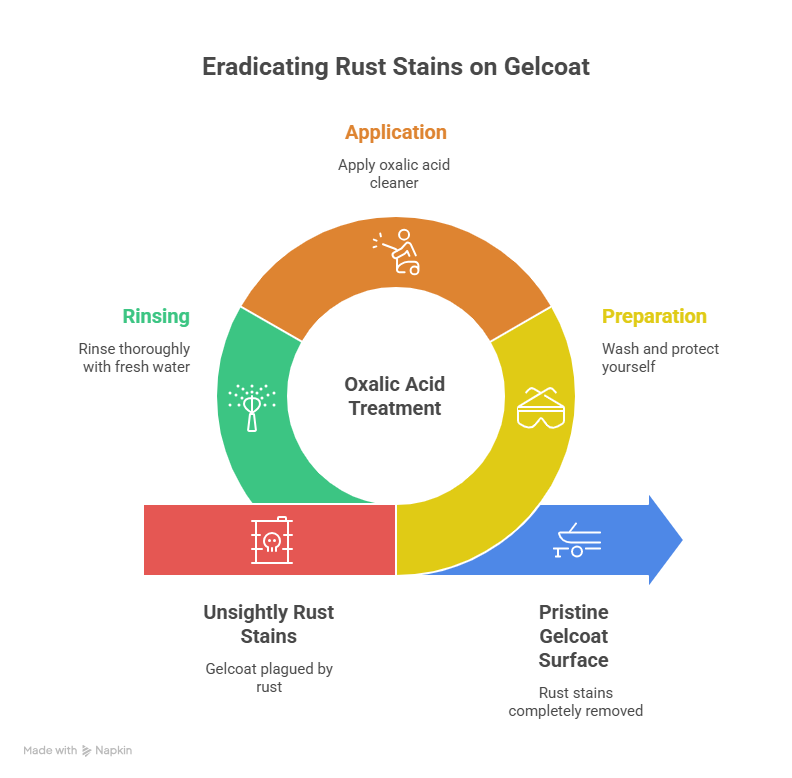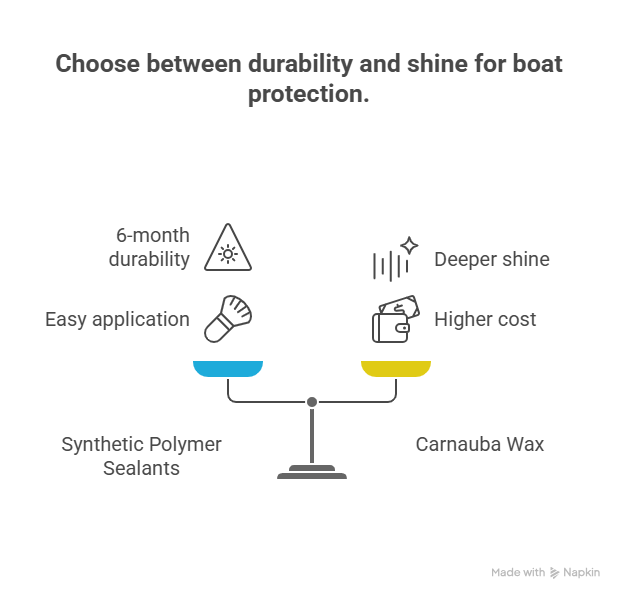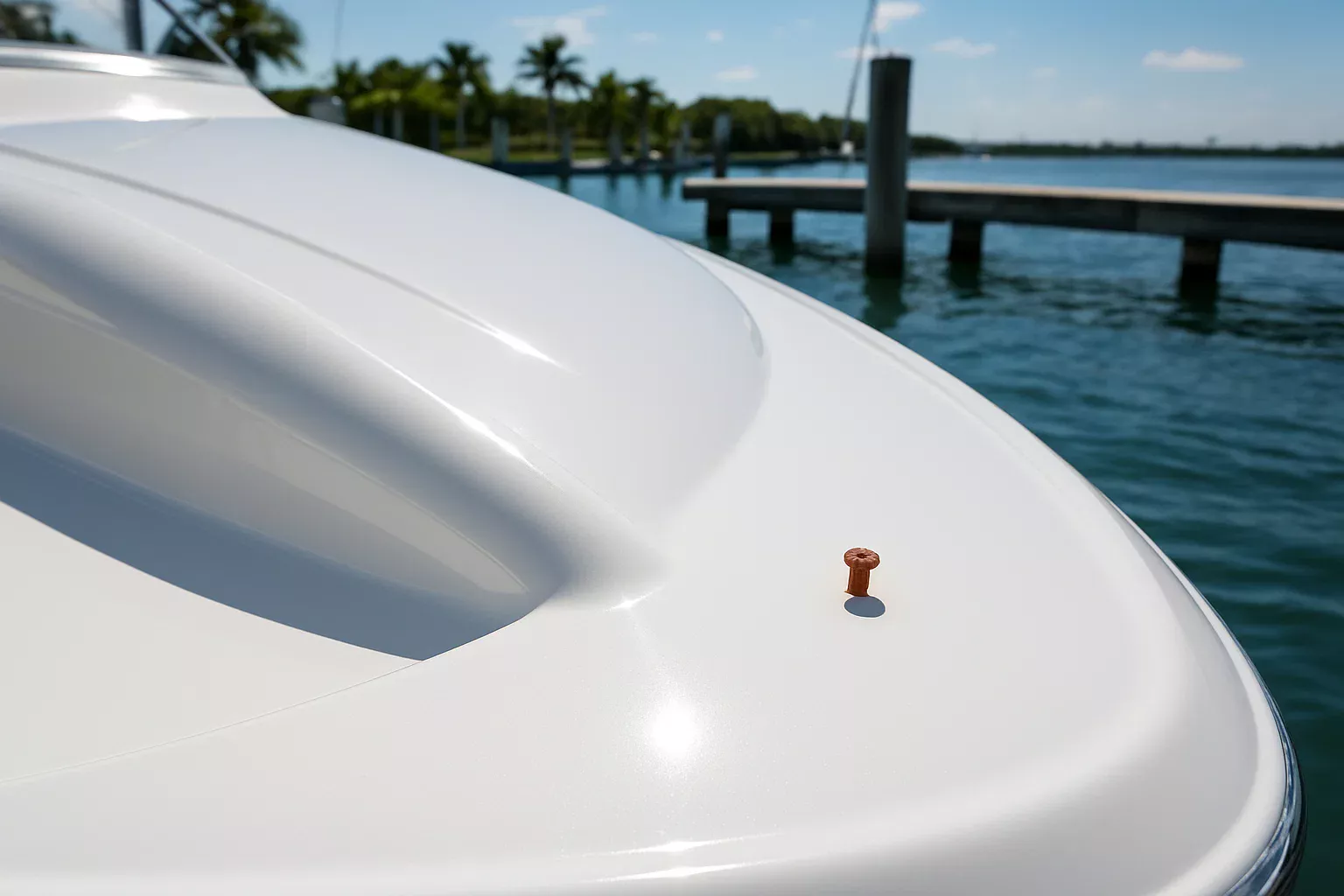I’ve been fixing boats in Miami and Fort Lauderdale for 15 years, and rust stains on gelcoat are a constant battle in this salty, humid air. Last summer, a guy named Javier at Dinner Key Marina brought in his Sea Ray 230 with ugly orange streaks running down the hull. “Ruins the vibe,” he said, kicking himself for leaving a rusty anchor chain on deck. I grabbed my oxalic acid mix, had it spotless in 20 minutes, and waxed it up to keep it protected. Here’s my playbook for erasing rust stains without wrecking your gelcoat, plus tips to keep them gone.
Table of Contents
What Are Rust Stains and Why Do They Plague Gelcoat?
Rust stains are the bane of every boat owner’s existence in South Florida. They’re not just dirt—they’re iron oxide, formed when metal particles hit your gelcoat, mix with oxygen and moisture, and stick like glue. Gelcoat, that glossy outer layer on fiberglass boats, is tough but porous on a microscopic level, so it traps those particles like a sponge. I learned this the hard way in 2010 when I scrubbed a client’s Boston Whaler with a scouring pad—made it worse and dulled the finish. Knowing what you’re up against is half the battle.
What Causes Rust Stains on Gelcoat?
Rust comes from iron, plain and simple. In Miami’s marinas, I see it from onboard hardware like screws or cleats “bleeding” during rain. Last July, a client’s Grady-White 208 had stains from a loose stainless steel snap—$50 fix, but a pain. External sources like dropped tools, fishing hooks, or rusty dock pilings at Bahia Mar are common culprits too. Even airborne industrial fallout from nearby ports can settle on your boat, especially in Fort Lauderdale’s busy waterways.
How Do Rust Stains Differ from Other Damage?
Not all stains are equal. Light orange streaks are surface-level and easy to zap with a good cleaner. But if they’ve sat for months, they can etch into the gelcoat, leaving pitting or a rough texture. I ran my hand over Javier’s Sea Ray last summer—smooth meant surface stains, but a gritty feel would’ve meant restoration work. Always check the texture after cleaning to decide if you need more than chemicals.
Why Is Acid the Secret Weapon for Rust Removal?
Scrubbing rust is a rookie mistake—chemistry does the heavy lifting. Acid dissolves iron oxide at a molecular level, pulling it out of the gelcoat’s pores without damage. I’ve tried every cleaner under the sun, and oxalic acid is the gold standard—strong enough to melt rust, gentle enough to keep your gelcoat shiny. In 2018, I helped a buddy at Key Biscayne clean his Yamaha SX210 with a DIY oxalic mix—saved him $200 over a shop job. Pick the right acid, and you’re golden.
Why Choose Oxalic Acid Over Other Cleaners?
Oxalic acid is the sweet spot for gelcoat. It’s in products like Star Brite Rust Stain Remover and works fast—stains vanish in minutes. Non-acidic cleaners, like dish soap, barely touch rust and waste your time. I once saw a guy at Stiltsville try bleach on his boat’s hull—useless and faded the gelcoat. Stick with oxalic acid, either store-bought or mixed yourself, for results without regrets.
What Cleaners Should You Avoid?
Harsh abrasives like scouring pads or Comet will scratch your gelcoat, making it a magnet for more stains. Muriatic acid is even worse—it’s so strong it can etch or “burn” the surface, leaving permanent damage. I saw a client in Coconut Grove ruin his gelcoat with muriatic acid in 2020—cost him $1,500 to restore. Avoid anything too aggressive; oxalic acid gets the job done safely.

How Do You Use Commercial Rust Removers Effectively?
Commercial products like Star Brite are my go-to when I want fast results with zero hassle. They’re buffered for marine use, so you spray, wait, and rinse—no guesswork. Here’s how I tackle rust stains at Dinner Key, saving time and keeping the gelcoat pristine.
How Should You Prep for Rust Removal?
Start with a quick wash using boat soap and water to clear dirt and grime. I did this on a client’s Sea Ray 350 last month—lets the cleaner hit the rust directly. Wear gloves and safety glasses; these products are mild but still acidic. Work in a shaded, well-ventilated spot—Miami’s heat can dry cleaners too fast. You’ll need a clean cloth, a hose, and your rust remover.
What’s the Best Way to Apply Commercial Cleaners?
Spray or wipe the cleaner onto the stain—don’t soak it. I applied Star Brite to Javier’s Sea Ray, and the rust melted in 30 seconds. No scrubbing needed; the chemistry does the work. Check the bottle for wait times—usually 1–2 minutes. If a faint stain lingers, hit it again, but don’t overdo it.
How Do You Rinse and Check the Results?
Rinse thoroughly with fresh water to stop the acid and clear residue. I missed this once early in my career—left a hazy spot on a client’s hull. Feel the surface after rinsing; smooth means you’re done, but pitting means you’ve got deeper damage. A second application often clears stubborn shadows, keeping your gelcoat flawless.
How Can You Safely Use DIY Oxalic Acid?
For budget-conscious boaters, mixing your own oxalic acid solution is a game-changer. It’s cheap and effective, but you’ve got to handle it right to avoid trouble. I’ve used this on dozens of boats in Fort Lauderdale, and it’s never let me down when done properly.
What Safety Gear Do You Need for Oxalic Acid?
Oxalic acid is no joke—it’s toxic if swallowed and burns skin or eyes. I wear chemical-resistant gloves, wrap-around goggles, and a respirator in tight spaces. Mix it outdoors, away from kids or pets, and avoid metal containers. I learned this in 2012 when I spilled some on a steel bucket—ruined it. Safety first, always.
How Do You Mix an Oxalic Acid Solution?
Aim for a 5% solution: 2–3 tablespoons of oxalic acid powder (sold as “wood bleach” at hardware stores) in a quart of warm water. Use a plastic container and wooden stir stick—metal reacts badly. I mixed this for a client’s Bayliner 285 in June 2024, and it worked like a charm. Stir until the crystals dissolve completely.
What’s the Process for Applying and Neutralizing?
Dab the solution onto stains with a sponge or paintbrush—watch the rust vanish in 5–10 minutes. I did this on a Yamaha jet boat last summer; the orange streaks turned to white powder instantly. Neutralize with a baking soda paste before rinsing to stop the acid—skip this, and you risk etching. Rinse with tons of water. Done right, your gelcoat looks factory-fresh.
Why Is Waxing After Cleaning Non-Negotiable?
Cleaning rust strips your gelcoat’s wax, leaving it naked against UV rays and new stains. I learned this in 2015 when a client’s unwaxed hull oxidized in months—$2,000 to fix. Waxing seals the deal, keeping your boat shiny and protected in South Florida’s brutal sun.
Why Does Gelcoat Need Wax After Rust Removal?
Acid cleaners remove wax along with rust, exposing the porous gelcoat. Without protection, UV rays cause chalky oxidation, and new stains grab on easier. I saw this on a boat at Bahia Mar—unwaxed gelcoat looked faded in a season. Wax is your shield, plain and simple.
Which Wax or Sealant Should You Choose?
I lean toward synthetic polymer sealants for their 6-month durability and easy application. Carnauba wax gives a deeper shine but fades in 2–3 months in Miami’s heat. Ceramic coatings last a year but cost more. For Javier’s Sea Ray, I used a polymer sealant—$30 and 30 minutes for a gleaming hull.
How Do You Apply Wax for Maximum Protection?
Work on a cool, dry surface in the shade. Apply a thin coat with a foam pad in 2×2-foot sections, let it haze (5 minutes), and buff with a microfiber towel. I did this on a client’s Grady-White last month—two coats, 24 hours apart, for bulletproof protection. Your boat will thank you.
How Do You Handle Stubborn Stains or Pitting?
Sometimes, rust leaves a shadow or rough texture even after cleaning. I ran into this on a Boston Whaler at Key Biscayne in 2023—pitting meant restoration, not just cleaning. Here’s how to tackle the tough stuff without ruining your gelcoat.
When Should You Consider Wet Sanding?
If you feel pitting or craters after cleaning, the rust has etched the gelcoat. Wet sanding smooths it out, but it’s tricky. I used 800-grit sandpaper on that Boston Whaler, followed by 1200 and 2000-grit to refine it. This is for pros or careful DIYers—too much pressure can wreck the finish.
How Do You Compound and Polish After Sanding?
Sanding leaves a hazy surface, so you compound with a machine buffer and cutting compound to remove scratches, then polish for shine. I restored a client’s hull this way in 2023—$300 job, but it looked brand new. Patience is key; rush it, and you’ll regret it.

FAQ: Common Questions About Removing Rust Stains from Gelcoat
Here are answers to the questions I hear most at South Florida marinas, optimized for quick, clear insights.
Why Do Rust Stains Keep Coming Back on My Boat?
They’re usually from onboard metal like screws or cleats. I saw this on a Sea Ray 230 last summer—loose snaps caused streaks. Find and replace rusty hardware, then wax regularly. A $50 sealant like Meguiar’s M66 saves you from repeat headaches.
What’s the Best Commercial Rust Remover for Gelcoat?
Star Brite Rust Stain Remover is my go-to—spray on, rinse off in seconds. I used it on a Yamaha SX210 at Coconut Grove, and stains vanished in a minute. It’s $15 and safe for gelcoat. Always rinse thoroughly to avoid residue.
Is Oxalic Acid Safe for DIY Rust Removal?
Yes, if you’re careful. Mix a 5% solution, wear gloves and goggles, and neutralize with baking soda. I cleaned a Bayliner’s hull this way in June 2024—$10 and 20 minutes. Skip neutralization, and you risk etching.
Can I Use Household Cleaners Like Vinegar for Rust?
Vinegar’s too weak for serious rust—it’s no match for oxalic acid. I tried it once in 2012; wasted an hour with no results. Stick to marine-grade cleaners or DIY oxalic acid for real impact.
How Often Should I Wax My Gelcoat After Cleaning?
Every 6 months with a polymer sealant, or every 2–3 months with carnauba wax in Miami’s sun. I waxed a client’s Grady-White twice last year—kept it stain-free. Unprotected gelcoat oxidizes fast.
What If Rust Stains Leave Pitting in the Gelcoat?
Pitting means the rust etched the surface, so you need wet sanding (800–2000-grit) and polishing. I fixed a Boston Whaler this way in 2023—$300 but worth it. Leave it to pros if you’re unsure.
How Can I Prevent Rust Stains in the Future?
Replace rusty hardware, rinse after saltwater exposure, and wax regularly. I tell clients at Bahia Mar to check fittings monthly—caught a $200 issue early last month. A $30 sealant goes a long way.
Comparison Table: Rust Removal Options I’ve Used in South Florida
I put this table together from jobs I’ve done around Miami and Fort Lauderdale:
| Method | Description | Cost | Time | Best For |
|---|---|---|---|---|
| Star Brite Rust Remover | Spray-on, rinse-off commercial cleaner | $15–$20 | 5–10 min | Quick, easy jobs |
| DIY Oxalic Acid | Mix 5% solution, apply, neutralize, rinse | $5–$10 | 20–30 min | Budget-conscious, large areas |
| Wet Sanding/Polishing | For pitted gelcoat; requires sanding and buffing | $200–$500 | 2–4 hours | Deep damage, pros only |
Conclusion: Keep Your Gelcoat Spotless and Protected
Rust stains don’t have to ruin your boat’s look or your day. With the right acid-based cleaner—whether a $15 Star Brite bottle or a $5 oxalic acid mix—you can make them vanish without scrubbing your arm off. I’ve cleaned hundreds of boats in South Florida, from Javier’s Sea Ray to a pitted Boston Whaler, and the trick is letting chemistry do the work, then sealing it with wax. Check your hardware, wax every six months, and you’ll keep your gelcoat gleaming for years. It’s not just about looks—it’s about protecting your investment for countless trips off Key Biscayne or Stiltsville.
Author Bio
I’m Alex, a 15-year marine technician based in Miami, with ABYC certification since 2010. I’ve cleaned and restored 300+ boats, from Sea Rays to Yamahas, across South Florida’s marinas. My work focuses on keeping gelcoats pristine in our harsh saltwater environment.


Leave a Reply